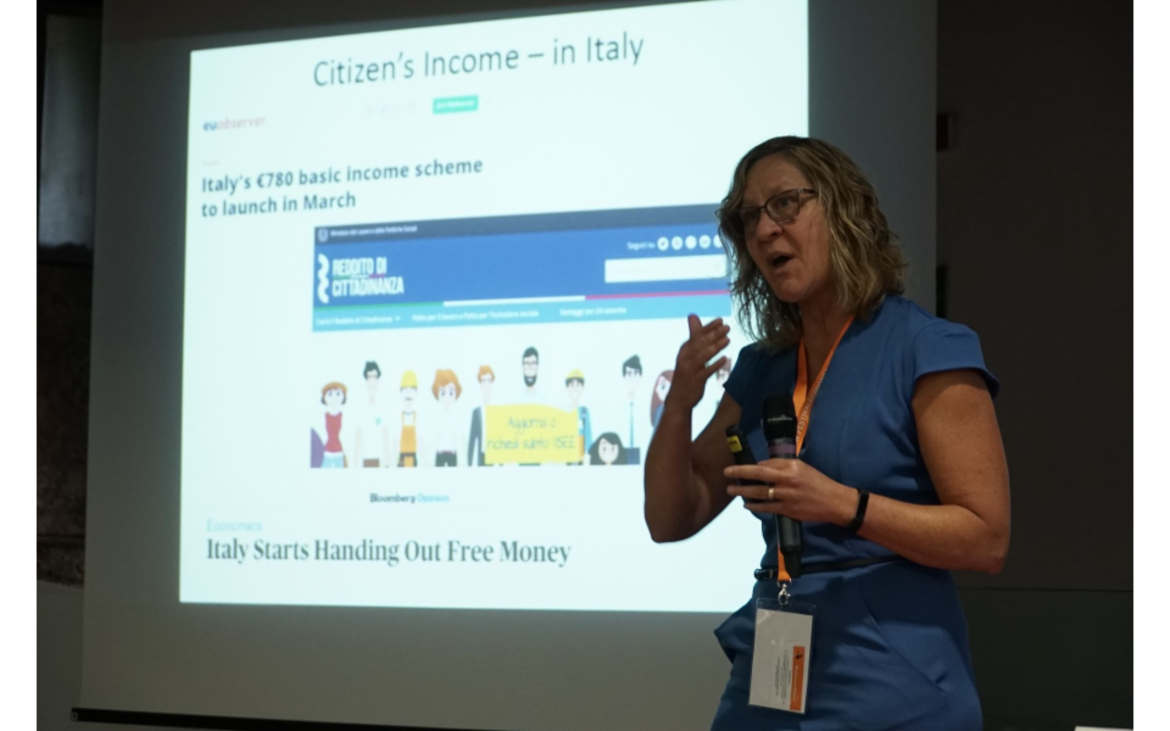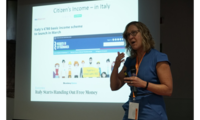
Hilary Hoynes, a Professor of Public Policy and Economics at the University of California Berkley, presented on the concept of a Universal Basic Income on the second day of the Economics Festival in Trento. She began by acknowledging that there has been a surge in the number of people who google “universal basic income.” She shared that there is little agreement about what a Universal basic income is and that the attention it is receiving may be running ahead of what problems it seeks to solve.
Hoynes shared that before examining a concept like the universal basic income, it is important to understand the problem that it seeks to solve. Hoynes attributed the problems that have led to the discussion surrounding the universal basic income to the secular trend down in labor force and employment rates particularly for men across the world, the fear of technological advancement and the idea that “robots” are coming to take the jobs away, and the stagnation of wages. Being that she mainly focuses on policies in the United States she mentioned that while the U.S. is a place with dramatic and rising inequalities, the region with the highest concerns is Southern Europe.
When analyzing why the issue matters, Hoynes expressed that it feeds into analysis of how much you care about certain issues such as, labor supply effects. Hoynes’ definition of Universal basic income has three dimensions. The first, is that it is paid to those without earned income and without any effort to find work. The second, it is paid to all, even those with high earned income (not phased out). The third, is that it is paid to all with no demographic targeting. She defines “basic” as being large enough to meet the basic needs of the people and “income” as, “in cash” rather than “in kind” referring to food stamps, food benefits and other examples that are not cash.
Next, Hoynes discussed the social safety net programs that already exist. She said most advanced economies already have social safety net programs. There are two questions that emerge when discussing the Universal basic income which are, “what is the UBI providing that is not or cannot be provided by the current social safety net?” and the other is, “Is the UBI a replacement or an addition to existing social safety net programs?”
The biggest challenge that greets the UBI is the question of cost. Hoynes takes the time to analyze the different models of the UBI, their costs and how their costs can potentially be lowered. She says the pure UBI has a benefit set at the poverty line which would be $12,000 per year with a total cost of $ 3trillion. In order to lower this cost, the UBI could be implemented with a “phase out” which essentially means that once a certain income is met, then the benefits are reduced. The consequence of this method is the more one moves towards phasing out the UBI, the more it begins to move towards a guaranteed minimum income program. Another measure to save cost is reducing the benefits at large. However, reducing the benefits results in losing the “basic” aspect of the program.
Next, Hoynes defined the concepts of “protection” and “distortion.” Protection indicates “out of work” where benefits provide protection against job loss. Distortion indicates when “out of work” where the benefits discourage work in general. Hoynes emphasized that almost always, the more protection that is given, the more distortion occurs. This is the main challenge of implementing a universal income, finding a way to provide money to people so they can meet their basic needs without minimizing the incentive to work. The second perspective, looks at when protection does not provide protection against job loss and distortion encourages employment.
After analyzing the Italian perspective through the “Reddito di Cittadinanza,” Hoynes came to the conclusion that this program is not “basic income” but a cash income program or a guaranteed income program. She finished up by sharing that if the main concern of implementing a Universal basic income program is the fear that the incentive to work will be lost, then the best alternative would be to implement a UBI with a “phase out” system.
Watch the video with Hilary Hoynes here
Website: https://2019.festivaleconomia.eu/home
Twitter: https://twitter.com/economicsfest
Facebook: http://www.facebook.com/festivaleconomiatrento
Instagram: https://www.instagram.com/festivaleconomia/








